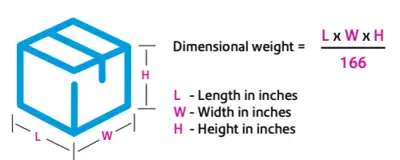
Dimensional (DIM) weight pricing FAQ
Why do carriers use DIM Rating
Lightweight, low-density packages were less profitable for carriers when charges were based on weight alone because they take up so much space in transport vehicles compared to high-density parcels. Carriers started using dimensional (DIM) weight rate calculations to establish a minimum charge based on the volume a package occupies.
How do I calculate DIM weight?
The DIM weight formula is straightforward: Multiply the length by width by height (in inches) of each package, then divide by the carrier divisor, which varies across carriers depending on where the parcel is being shipped and other factors.
Example: A 2 lb. parcel is 12” x 12” x 12”. Multiplying these yields a total volume of 1,728 cubic inches, which is divided by the carrier divisor. The USPS divisor is 166, and 1,728/166 = 10.41 lbs., which rounds up to 11 lbs. This is the DIM weight which will be used for this parcel’s shipping rates.

What size packages qualify for DIM weight pricing?
- For UPS and FedEx, packages starting at 6” x 6” x 6” qualify for DIM pricing.
- For USPS, packages that are greater than one cubic foot (length x width x height > 1,728 inches) are subject to DIM pricing.
What role does weight play in calculating cost?
Carriers use the higher of the DIM weight and physical weight of each parcel to determine the final pricing.
How can I minimize shipping costs?
- Choose the right box size, so you’re shipping as little empty space as possible.
- Use lightweight filler, and as little as possible to protect your shipment.
- Don’t overstuff the box. Sometimes it’s more economical to split your shipment into two or more parcels.
What happens if DIM weight is calculated incorrectly?
FedEx and UPS will add extra charges on your next statement in the adjustments section of your invoice. If a USPS package is calculated incorrectly, postage will be due upon arrival at recipient’s address or returned to sender for insufficient postage.
Do Pitney Bowes mailing and shipping solutions calculate DIM weight?
Our PitneyShip® software automatically calculates the DIM pricing for your larger packages based on the dimensions of the box. The PitneyShipTM Cube, the first-ever shipping label printer with a built-in scale, simplifies shipping even more with the PitneyShip mobile app that can automatically capture the dimensions of your package.